World War 2 Aircraft
World War 2 Weapons and Air War
part 2
Contents
Part 2
World War 2 Aircraft
Bombers
Fighters
Paratroopers
Part 1: WW 2 Weapons
Part 3: WW 2 Ocean War
Bombers
The startling distinction between the "Great War" (1914-1918) and World War 2 was the emphasis on the air war. In World War 1, the airplane was basically utilized for observation and infrequently employed in offensive actions.That strategy was reversed as the first shots were fired in Nazi Germany's invasion of Poland on September 1, 1939 (Operation--"Fall Weiss").
The German blitzkrieg was built around their armored tanks, 850 JU-87 dive bombers and 400 fighter planes acting in concert and coordination. Comparable Polish power: 210 bombers, 150 fighters. German armor established the bridgeheads, and the planes knocked out command posts. Then the Wehrmacht ("defense force" = infantry) crossed into the gaping breach. This was completely new era tactics never envisioned by the military planners of World War l, and probably not on the drawing boards of the western industrialized countries.
World War 2 Aircraft
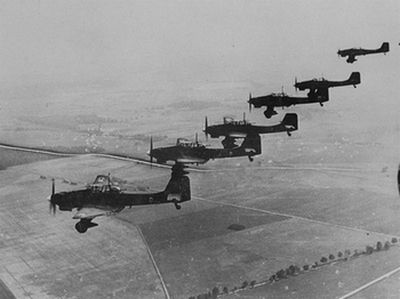
However, the German planners also miscalculated. They failed to realize that their bombers were unprotected by fighters over enemy territory. The Ju-87 range
limited their bombing time over England to 30 minutes, and also required
constant changes to their ammo magazines every 75 fired rounds. They
were particularly vulnerable to the British Spitfire and Hawker
Hurricane fighters.
|
World War 2 Aircraft 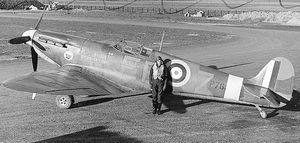 Spitfire Hurricane |
World War 2 Aircraft 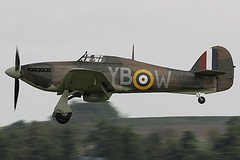 |
Germany produced over 70 diverse or upgraded designs of aircraft. The United States probably surpassed that number prior to the December 7, 1941 entry into the war. Great Britain, with far more limited production capability, had over 40 models on their tarmacs. The Japanese were as prolific as the English. Gone were the days when bombs were dropped from open cockpits.
The British entered the war with their own fighter/dive bomber. The 2 seat Skua was the air arm of the Royal Navy. It operated at 200 MPH at sea level but was hampered by a poor rate of climb to a 20,500 foot ceiling. It had another draw back. This was a carrier based plane with no radio communication except by Morse code over by radio signal---and no other way than hand signals to fellow pilots in the air. Navigation was left to the map resting on the pilot's lap.
The Skua mounted 4 Browning machine guns in
addition to a rear cockpit gun. It had one armor piercing 500 lb bomb
load and four 20 lb incendiary bombs. Nevertheless, the plane had an
exemplary history. The dive bomber sunk the German cruiser, Konigsberg
while it was at anchor in the Bergen harbor a day after the Nazi
invasion of Norway on April 8, 1940.
The Skua claimed the first air kill of a German plane (September 25, 1939)---Dornier DO Flying Boat.
|
World War 2 Aircraft 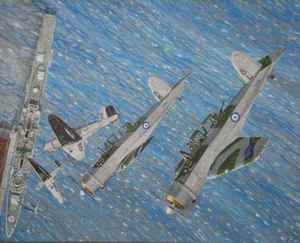 |
World War 2 Aircraft 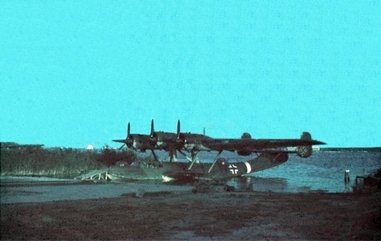 World War 2 Aircraft |
In early June 1940, the British and French troops were
cornered on the coastal beach of Dunkirk in north western France. The waters were filled with
French and British warships boarding their trapped troops over nine
days. The weather was so poor that the Luftwaffe had less than 3 days
for their dive bombers to operate. They did sink 7 French and 6 British
destroyers and 5 large passenger ships, Over 300,000 troops escaped to England.
The
Germans lost 156 planes and the British lost 106 fighter aircraft.
Winston Churchill claimed that the air war was an English victory
despite losses displayed below on the Dunkirk Beach. Keeping up domestic morale was part of the war effort. Churchill had learned that the enemy could now be guided to English targets by a radio beam that could pierce fog.
World War 2 Aircraft
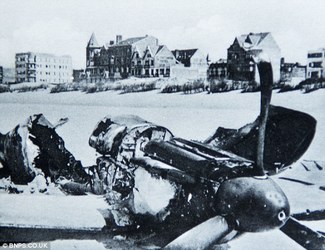
World War 2 Aircraft
Reichsmarshall Hermann Goering, Commander of the Luftwaffe, and a World War 1 air ace, guaranteed Adolph Hitler that the air force would destroy the British R.A.F. This would open the way for the invasion of England scheduled for September 15, 1940--Operation Sea Lion. The air strike--Operation Eagle-- would pit 3500 German planes against an estimated 700 Spitfires and Hurricanes commanded by air Chief Sir Hugh Dowding.
Despite numerical inferiority, the
British held some strong cards. They established a "Chain Home" system
of 30 radar stations along the English coast. The data gathered on
altitude and numbers of enemy air craft was quickly disseminated to the
military airfields in time to scramble their fighters. Germany also used
radar effectively to defend against English bombers. Daylight raids
would prove disastrous for both sides.
There was another British advantage. Their scientists had cracked the secret code of the German Ultra machine with their own Enigma decryption machine. They now knew the destination of the bombers. The ability to decode was kept under tight wraps. One of the toughest decisions of the war was failure to alert the citizenry of Coventry of an impending raid. Casualties were brutally high and 12 airplane factories were destroyed (November 14, 1940) by 300 German bombers. This triggered a series of revenge bombings. The British launched a 103 bomber raid against Mannheim.
Tactical bombing against a specific target was the new norm, rather than
random drops. The original and unexplained policy, stated by Air Minister
Kingsley Wood, prohibited the Royal Air Force from bombing German factories on the ground
that they were private property. That policy by mid 1940 was dumped. The
British in May 1940 began bombing the Ruhr Valley, the
industrial
heart of Germany. Although bomb sights were less than perfect,
precision bombing was now part of bombing campaigns. In August of 1941,
only one third of bomber commands made drops within 5 miles of the
target as recorded by aerial photography. The Americans began the war
with the Sperry bomb sight, but by 1943 the Norden sight replaced it
with its greater accuracy.The Norden was a technological leap. The optical, mechanical gyroscope passed
control of the plane, as it neared the bombing location, to the bombardier.
Britain's 7 bombers: Hadley Page Halifax, Hampden, Lancaster, Stirling, Wellington, Whitly, Blenheim
World War 2 Aircraft Halifax Lancaster World War 2 Aircraft
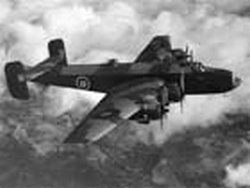 |
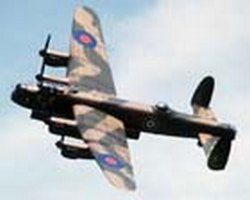 |
In February 1941, Britain began turning out Hadley Page and Stirling bombers capable of reaching Hamburg targets. They bombed Cologne with a force of 1000 bombers. It was no secret that striking civilian morale and consequently reducing the work force was a prime object of these raids
World War 2 Aircraft
World War 2 Aircraft
United States Bombers--5 models: B-17 (Fortress),B-24J (Liberator), B-25J, B26E, B-29 (Super Fortress) with numerous model variations in addition to a dozen other models.
World War 2 Aircraft B-24J B-29 World War 2 Aircraft
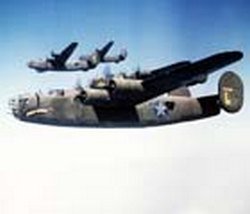 |
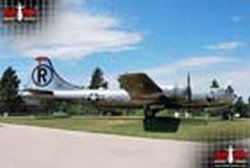 World War 2 Aircraft |
The B-24 Liberator began its career in 1941. Over the next four years, 18,800 would be built. It was particularly effective in the Pacific although used in European Theater, and even attacked submarines. Because of its extensive range, they bombed Tokyo over a two hour span. Two hundred seventy-nine planes reached the target leaving enormous casualties on the ground, Twenty-nine planes were lost.
Below, the Liberator used in an attack destroying Romanian oil field August 1, 1943.
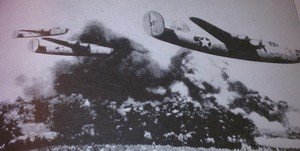
The introduction of the B-29 super Fortress into the European Theater brought the state of the art to the early years of the war. A computer calculated range, altitude, air speed and temperature. All guns were fitted with interceptors to prevent striking the plane.
The rear and waist gunners controlled their weapons, but the turret gunner from his vantage point coordinated all the guns. Targets were controlled by radar operator and bombardier.
By May 1944, these planes had bases around the globe. Their mission was the destruction of military assets, soldiers, industry and morale. In this year, they bombed Japan. By November, a string of islands were captured furnishing forward bases for the B-29.
Bomb loads were varied. Incendiary, anti personnel,
smoke, deep penetration could create 80 foot craters. The English had
introduced dam busters in 1943, and were used to flood the Ruhr Valley. Air reconnaissance revealed that 134,000,000 tons roared down the Ruhr Valley. Note the breach in the dam below.
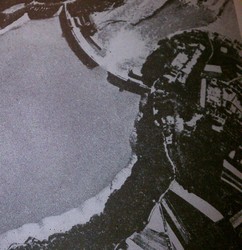
The B-25 bomber was known as the Mitchell bomber named for World War 1 ace, Billy Mitchell who had preached the value of carrier based planes. On April 28, 1942, 16 Mitchells took off from the deck of the USS Hornet bound for a target 800 mile distant---Tokyo. This would be a first strike at the Japanese home islands. To save weight the plane was stripped. Guns were removed from the rear turret. The lead pilot was Lt. Colonel James Doolittle who would further distinguish himself in the war. The raid caused little damage. As per the plan, in which there was no provision for refueling and without the ability to land a B-25 on the deck of the carrier, they forced landed in China where some were rescued by Chinese and others captured. Ultimately, 14 crews returned with the exception of one crew member.
A month later, the B-25 performed exemplary service in the successful Battle of the Coral Sea.
The U.S. Navy had its pet dive bomber, Douglas SBD 3--Dauntless. It was powered with a 1000 HP engine and flew at 250 MPH. Its ceiling was 27,000 feet with a range of 1345 miles. Tucked under the wings were 100 lb bombs, but its main load were 1000 pound highly, explosive bombs. Add to that 5 guns and well armored protection. Despite certain limitations of power, range and hard to fly, they sunk more Japanese tonnage than any other plane.
The dive would start between 1000 to 2500 feet for a 6 plane squadron; all following the leader into a banking dive. The bombs were released manually, but toward the close of the war an electric release was added.
In early June, 1942, the battle for control of Midway was raging. Plane strength of about 300 planes was equivalent with Japanese force. The Japanese had a decided advantage in the number of ships off shore. The U.S. land based planes, combined with those on the carriers, attacked the enemy fleet, but were repulsed by the Zeros. A second attack aided by code breakers passed information to Admiral Nimitz. It caught the Japanese carrier based planes refueling. 37 Dauntless dive bombers from the Carriers Enterprise and Yorktown with Marauder bombers, and their2000 lb pound bomb load, helped to rout the Japanese ships. Midway Island was saved. .
World War 2 Aircraft
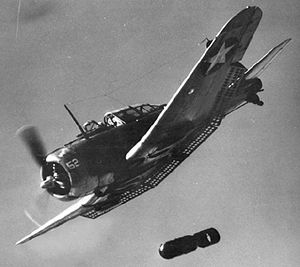
World War 2 Aircraft
Night bombing depended on moonlight. Weather was always a factor for bomber activity. March 30, 1944, a raid was planned on Nuremburg over 500 miles from English bases.. Bomber Command was prepared to stand down on reports of bad weather. Then there was a conflicting report of improved weather and the raid was cleared. German fighters took advantage of the weather, and shot down 85 planes. German fighters were still capable of a strong defense.
In one three month period from August 1, 1941, the British lost 350 planes. By that winter, daylight raids were deemed completely ineffective, but night time raids, with deep penetrations meant no fighter escorts and heavy losses.
In 1942, the U. S. Air Command, USAAF, despite both British and German experience with daylight bombing, believed their heavier armored bombers, B-17, could accomplish what the British could not.The U.S. believed that the two strategies, day and night raids, would be effective. There was a minimal hope in the minds of the British and American commands that combined bombing would obviate the necessity for a land invasion. This undercurrent guided the mission of the U.S. Eighth Air Force. Help was on the way for the daylight bombers.
In 1943, the American P-51 and P-47 fighters with longer ranges, were an effective screen for the bombers, and reduced their losses significantly. This was even true for daylight raids
The Boeing B-17 "Fortress" would go through 15 evolutionary designs, and 12,000 were manufactured by several American corporations. The first of 20 planes were introduced to British pilots in 1940, and then, in 1942, Americans were heavily dependent on the "Forts". This huge, 4 engine plane with nose and turret guns, was the only heavy bomber in the RAF prior to their manufacture of the Stirling and the Hadley Page. On one bombing flight, a B-17 squadron was led by Major Paul Tibbets who would, three years, later carry and drop the first atomic bomb on Japan.
The American Command believed that the Flying Fortress had the guns and armor to fly without fighter escort. In October 1943, the bomber loss count for the month was 176. The German fighters were very effective as well as their anti aircraft guns that filled the sky with flak. The B-17s flew in tight formations adding to the density of the bombs and fire power, but offered the Germans better targets. These bombers would ultimately drop from a high altitude over 600,000 tons of bombs. Another hazard of a tight formation was the possibility of being struck by a bomb from a friendly bomber flying at higher altitude. Definitively the B-17 insured U.S. air superiority in Europe despite armor limitations. The crewman, in the nose, lacked bullet proof glass, suffered from cold temperatures and oxygen malfunction that caused nausea.
In October 1944, this B-17 returned safely to English airfield from a raid on Cologne with the unfortunate loss of the nose gunner after a direct hit from ground fire. A testament to the flying skills of the pilot and a superbly engineered plane.
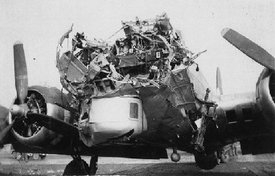
The records of the U.S. 20th Air Force clocked 49 missions for its 3,058 aircraft and dropped over 11,000 tons of bombs. Their contribution to the 600 tons that fell through bomb bay doors mainly on German cities.
The B-17 Fortress was not extensively used in the Pacific Theater.
|
World War 2 Aircraft 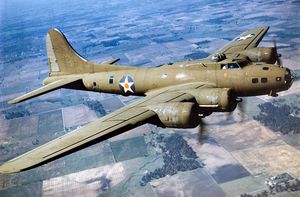 |
World War 2 Aircraft 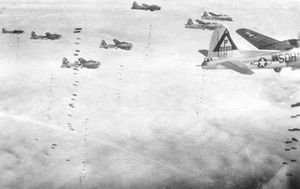 World War 2 Aircraft |
The variety of bombers flying across the globe was extensive and each year brought either a new model or a variation of an original. The variations were almost infinite. . The United States had over 30 models in their air arsenal.
The coup de grace: On July 24, 1945, General Spaatz, Commander of the new U.S. Strategic Air force set a date for a visual drop of the atomic bomb. August 2 was chosen. Paul Tibbits Jr. to fly the mission. He was a veteran pilot of many bombing missions in Europe. As a young officer, he had been chosen to fly General Eisenhower to Africa from England during Operation Torch.
His plane, a B-29, named "Enola Gay", took off from a secret Utah base. On August 2, after the "bomb" was dropped, he visually noted the destruction of Hiroshima sustained by a 900 lb atomic bomb, dubbed "Little Boy". Seven days later, "Fat Boy' was dropped on Nagasaki, a victim of the bomb and the weather. The original target was the City of Kokura, but cloud cover caused the plane to divert its target.
September 2, 1945: General Douglas McArthur, aboard the USS Missouri , observed the Japanese sign the surrender agreement. He declared; "The proceedings are closed".
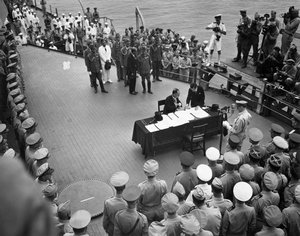
aboutjapan.japansociety.org
German-4 models: Dornier, Heinkel, Junkers Stuka, Junkers 188 Avenger, The German engineering genius produced the first pressurized cabin in a Junker 864. This eliminated the need for the crew wearing oxygen machines at high altitudes. In 1942, they could breath normally at 40,000 feet over England.
|
World War 2 Aircraft Heinkel 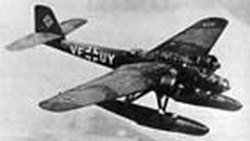 |
World War 2 Aircraft Junker 188 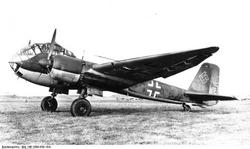 |
An American nurse stationed in a medical station in Anzio, Italy vividly recalled the hospital hit by a German bomb. Sergeant Smith was her assistant. "I saw Smitty clutch at his desk and then sink to the floor. I lay next to Smitty in the ambulance. What about a cigarette , he asked. I got one out and handed it to him. He drew two deep puffs and it fell from his fingers. Smitty was dead".
Japanese flew 4 models of the Mitsubishi. Each carried a different Ally code name: Betty, Sally, Nell, Peggy . Nakajima manufactured 2 models: Helen, and Nakajima -Kate. Each model was an effective bomber, but not necessarily in its own defense. The "Peggy" was found best of class. All were well armored.
The "Sally" had a range of 1350 miles. It fared poorly against British Hurricane fighters and the U.S. P.40s in the skies over China and Burma,
The "Helen" had a short range for a bomber, was slow, and carried a small bomb load.
The "Betty G4M" had a 3,000 mile range, well armed and a bomb load over 2,000 lbs. Their Achilles heel was their unprotected tanks. When they altered those tanks to make them self sealing, they reduced the rate of speed. They were comparable to the British Blenheim bomber.
The Nakajima "kate" was a single wing dive bomber that carried a 1760 lb torpedo. On December 7, 1941, 144 took off from their carrier decks. Their torpedoes were responsible for much of the damage suffered by the U.S. navy in Pearl Harbor. In later engagements. they sunk 4 U.S. carriers at sea: Hornet, Lexington, Wasp, Yorktown. As the war began, the Japanese air force had a 2-1 edge in numbers over allied airplanes.
In a comparable action on December 7, 53 Japanese bombers escorted by 36 fighters hit Clark Field in the Philippines destroying B 17s and P-40s on the ground.
The Japanese had a strategy that the United states was yet to learn, and that curve began while the Americans were on the defensive. The enemy plan began with good intelligence, and then centrally integrated ground, air and navy services acting in concert. Their air force provided the initial strikes in the way the artillery barrage did on the ground.
|
World War 2 Aircraft Mitsubishi Nell 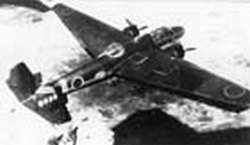 World War 2 Aircraft |
World War 2 Aircraft Mitsubishi Peggy 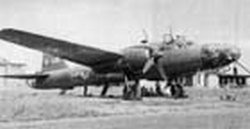 World War 2 Aircraft |
World War 2 Aircraft
Fighters
The bombers were all vulnerable to the fighters. But not all fighters were created equal. Nor were all pilots even given the equality of training. Speed, maneuverability, rate of climb, range, fire power, armor, reliability determined the fighter's survivability. Every sortie might involve meeting an enemy fighter, and the inevitable "dog fight". Each air force had its standouts in terms of performance.
World War 2 Aircraft
The Supermarine MK24 Spitfire was the British pick during the air battle over Britain. Reputably, faster than the Hurricane, but slower to build. However, it was the Hawker Hurricane that carried the greatest burden in the Battle for Britain. Its rate of victories was greater than that of the Spitfire. The Hurricane's 20mm cannon was devastating, and performed equally as well in the Pacific as in European skies. The Hurricane pilots were particularly adept in emphasizing the strong points of their craft and avoiding its limitations. Both of these single seat fighters prevented a Nazi invasion.
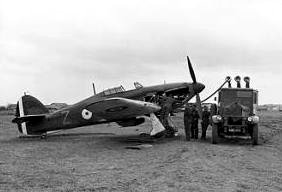 Hurricane Spitfires War History on Line |
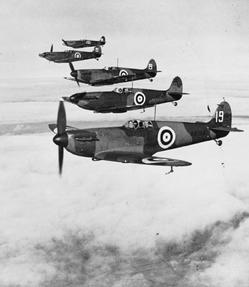 |
The Vought Corsair began its career as a land based plane. The U.S, Navy converted it for sea duty in 1943.This single seat fighter flew at 400 MPH. Its kill ratio of Japanese
planes was 11 to 1. The plane was still in use in Korea over 10 years
later.
The U.S. Curtis P-40. like the British Hurricane, had system limitations, but was very reliable and durable. It was mostly associated with the "Flying Tigers" operating in China nnder the leadership of General Claire Lee Chennault. The dual quality of fighter and bomber made it the 3rd most manufactured plane in the U.S. air force. 3,000 of these planes were highly prized by Soviet pilots supplied under the "Lend Lease" program. Ultimately it was replaced by the P-39, P-47, P-51. The P-51 Mustang outclassed all German fighters. Its formidable range allowed it to accompany deep penetration bombers in Germany. No longer could German fighters await escort fighters to return to English bases to refuel and leave their bombers without fighter protection. It restored the U.S. daylight bombing viability.
P-40 fighter below -furnishing ground support for American infantry assaulting Solomon Island beach June 30, 1943.
World War 2 Aircraft
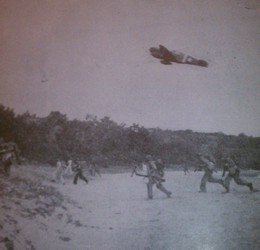
|
World War 2 Aircraft 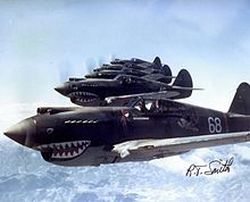 |
World War 2 Aircraft 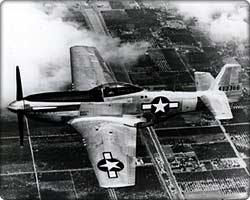 |
The Germans were active in manufacturing high design fighters. Their Focke-Wulf FW 190 could out fly the Spitfire but could not compete with the P-51. The Messerschmitt 109K was constantly active over Britain, and on the continent. It had a range of 420 miles at a speed of 354 MPH. As good as the Spitfire in many respects, except high speed maneuverability was poor, but its 20mm cannons and 9mm guns provided high fire power.
|
World War 2 Aircraft Focke-Wulf 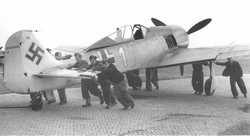 |
World War 2 Aircraft Messerscmitt 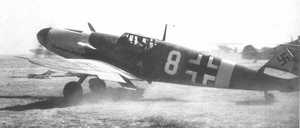 |
The Lightning P-38 was an impressive twin tailed fighter. The Germans referred to it as a "forked tail devil". It mounted a 20mm cannon and 4 machine guns.The Germans had a design for a Heinkel fighter, but never was manufactured.
The Japanese sought to match the American P-38 with their Nakajima Ki-84, but could not. They produced a plane that was the equal of the P-51, but fell short of the higher performing Lightning. The Japanese produced 3,000, but too late in the war to make a difference.
|
World War 2 Aircraft 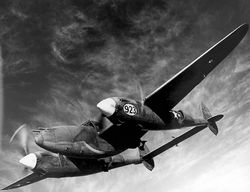 |
World War 2 Aircraft 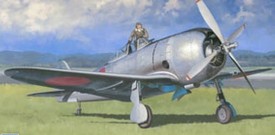 Nakajima P-38 World War 2 Aircraft |
The Japanese navy used its Mitsubishi Zero as its Pacific work horse. 43 of those planes left their 6 carrier flight decks on the morning of December 7, 1941, and flew 275 miles to attack Pearl harbor to drop its torpedoes and strafe Hawaiian civilians. It was also part of a second flight of 170 planes one hour later. This plane was part of the Japanese success in the first 6 months of its Pacific Island campaign. The Japanese success was incomplete. They missed the three U.S. aircraft carriers that were out to sea, and failed to destroy the large fuel dumps and submarine pens.
In a similar action on the same day, Zeros strafed Americans and Philippians on Luzon Island. It was all out war as President Roosevelt responded with his declaration of war.
World War 2 Aircraft
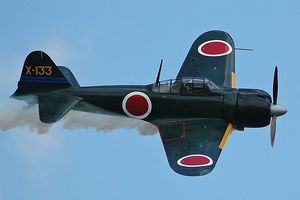
World War 2 Aircraft
Paratroopers
The paratrooper is the true hybrid of the World War 2 air war. His duty began in flight and started again on the ground behind enemy lines. He was a member of the Airborne Service.
On September 1, 1939,
the German paratrooper was the first enemy soldier to invade Polish
airspace, and the first to contact Polish soil. He was in the vanguard
of what the world would soon call the Nazi blitzkrieg designed to shock
and disorient the enemy. These soldiers were considered special and carried a specific identity card.
World War 2 Aircraft
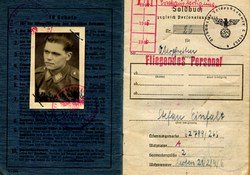
World War 2 Aircraft
The template that they set on that September day would be reenacted dozens of times over the next seven years. This included the training to prepare this soldier for the danger in the air, and on the ground. The risks began on the plane that transported them that was a target of enemy artillery and planes; in the air, after the jump, the same target without the plane's shell for protection. Once on the ground the risk of the light infantry man is assumed."Light" infantry because there is a lack of resources other than the weapons carried and no transportation. However, as the war progressed, air drops with supplies, became routine.
Once the paratrooper slipped out of the parachute's harness he would join his comrades, and proceed to targets that included capturing and holding bridgeheads and cross roads for the armor and troops to follow. The paratroopers were charged with the duty to destroy enemy command posts and interrupt their zones of central control.
The Germans rapidly repeated these tactics in their April 1940 invasion of Norway and Holland. In Norway, the Germans coordinated the paratrooper attack with a sea operation. In Holland, the invasion began with a two division air drop.
On September 5, 1943, Americans attacked the Japanese on New Guinea. The attack began with an air drop accompanied with a protective smoke screen.
World War 2 Aircraft
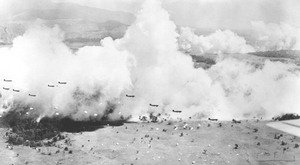
In Europe, at almost the same time as the new Guinea air drop, paratroopers sought to gain a beachhead at Salerno targeting Naples and Rome. The drop was in the wrong zone and resulted in stiff ground resistance. The paratroopers suffered 30% casualties. Nevertheless, the paratroopers held the ground permitting General Mark Clark's forces to gain a foothold.
Both daytime and night time drops were risky. The former creates an open target for enemy gunners and the latter creates confusion in locating comrades. On D Day, June 6, 1944, the first drops were in darkness. Some paratroopers fell into marshes and drowned. Many of the airborne troops arrived over their targets in gliders and crashed with significant casualties. The American airborne divisions were represented by the 82nd and 101st divisions that were immediately engaged with the German defenders.
Easy Company 506 was ordered to secure an area several miles from the American beachhead on Utah Beach. They immediately ran into 3 artillery pieces at Becourt emplaced with guns trained on Utah Beach. The guns were protected by an infantry platoon. The paratroopers dispatched the enemy and saved innumerable Americans landing on the French beach. General Eisenhower spoke to paratroopers before they bordered their transport planes and wished them good luck.
World War 2 Aircraft
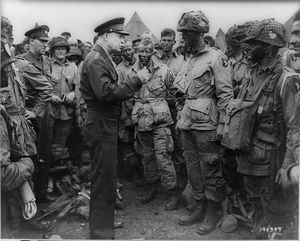
During the September following the Normandy invasion, General Bernard Montgomery pushed a plan (Market Garden) to invade the German industrial heart in the Ruhr Valley.
The invasion began with air drops in Holland using the British 1st Airborne and the U.S. 82nd and 101st Divisions. There were early successes in capturing bridges, but German resistance was fierce. The 101st was subjected to a heavy aerial attack. The attacking force also included Polish paratroops.
Although the airborne forces had achieved many of its objectives, they only had the ability to hold their gains for short periods expecting reinforcements. Those reinforcements were not forthcoming in a timely manner. After several days, the Allied troops were forced to withdraw. Their efforts to cross the several rivers that protected Germany was successful, but they could not hold their gains against strong German resistance. What had been an offensive action, became a defensive retreat. In short, Market Garden was a failure, and an unnecessary loss of lives.
World War 2 Aircraft
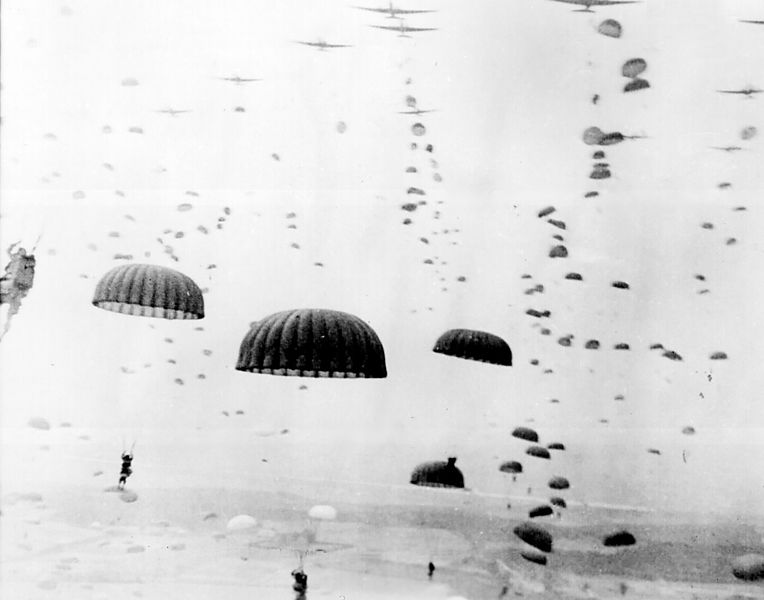
World War 2 Aircraft
As the war in Europe was closing in 1945, the Americans and Germans were racing to create a new class of airplanes that never saw service in the war.
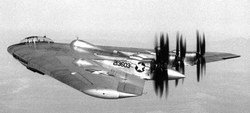 German's experimenting with rocket propulsion. |
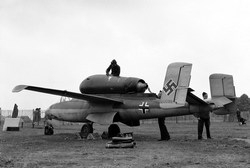 |
______________________________________________________________________
Part 1: World War 2 Weapons (Land)
Part 3: World War 2 Weapons & the Navy
American Wars | Causes of World War 2 | World War 2 Aircraft